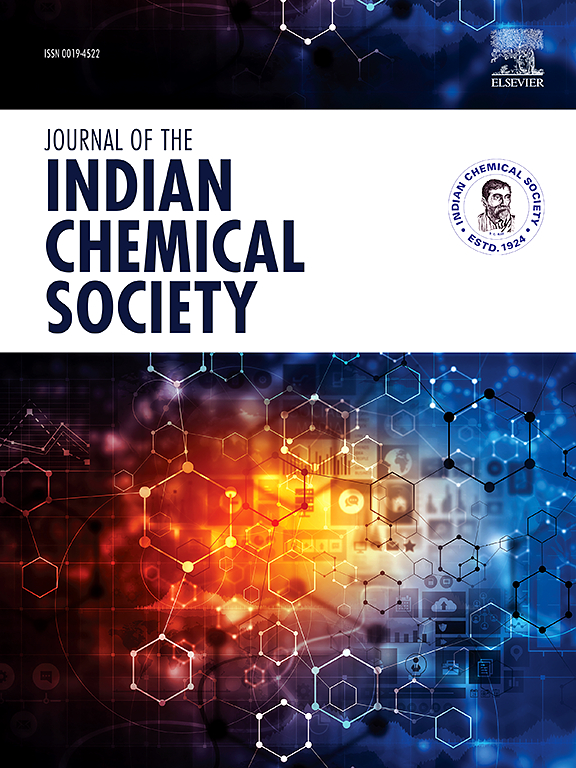制备用于去除有害孔雀石绿有机污染物和选择性二氧化氮气体传感器的改性 Sb2O3 纳米球
IF 3.2
4区 化学
Q2 CHEMISTRY, MULTIDISCIPLINARY
引用次数: 0
摘要
采用低成本共沉淀法合成了 Sb2O3 和镍修饰的 Sb2O3(Ni-Sb2O3)纳米球,并使用多种仪器方法对其进行了表征,如 X 射线粉末衍射 (XRD)、高分辨率透射电子显微镜 (HR-TEM)、扫描电子显微镜 (SEM)、能量色散 X 射线光谱 (EDS) 和傅立叶变换红外光谱 (FT-IR)。X 射线衍射图显示了立方晶格。经计算,Sb2O3 和 Ni-Sb2O3 纳米粒子的平均尺寸分别约为 41 纳米和 29 纳米。对 Sb2O3 纳米材料进行的 HR-TEM 研究表明,该纳米材料呈均匀的球状,分散性很好。扫描电镜显示出随机形状的纳米颗粒,表面有多孔和空隙。EDS 检验证实了 Sb2O3 中 Sb(41.79 %)和 O(58.21 %)的元素组成,以及 Ni-Sb2O3 中 Sb(36.80 %)、O(58.95 %)和 Ni(4.25 %)的元素组成。根据紫外可见光分析,Sb2O3 和 Ni-Sb2O3 的带隙分别为 3.67 eV 和 3.51 eV。在 Sb2O3 和 Ni- Sb2O3 中,红外峰分别为 445.47、642.18 和 745.18,红外峰分别为 438.72、645.07 和 756.92。合成的纳米材料已被用于光催化降解孔雀石绿(MG)染料,以及感知二氧化氮、二氧化硫、二氧化碳、石油蒸汽和液化石油气。在优化条件下(催化剂剂量:0.1 克/升至 0.3 克/升,pH 值:7,孔雀石绿染料:10 ppm),使用 Ni-Sb2O3 在 120 分钟内降解了 97.67%的孔雀石绿染料。气体传感研究表明,Ni-Sb2O3 传感器对二氧化氮气体具有更高的灵敏度和选择性。本文章由计算机程序翻译,如有差异,请以英文原文为准。

Fabrication of modified Sb2O3 nanospheres for the removal of hazardous malachite green organic pollutant and selective NO2 gas sensor
Sb2O3 and Ni modified Sb2O3 (Ni–Sb2O3) nanospheres were synthesized using low cost co-precipitation method and characterised using various instrumental methods such as X-ray Powder Diffraction (XRD), High Resolution Transmission Electron Microscopy (HR-TEM), Scanning Electron Microscopy (SEM), Energy dispersive X-ray spectroscopy (EDS), and Fourier-transform infrared (FT-IR) spectroscopy. The XRD pattern reveals cubic crystal lattice. The average size of Sb2O3 and Ni–Sb2O3 nanoparticles was calculated to be around 41 nm and 29 nm, respectively. The HR-TEM investigation of the Sb2O3 nanomaterial reveals homogeneous spherical balls with a fine dispersion. The random-shaped nanoparticles with porous surfaces and voids were revealed by SEM. EDS examination confirms the elemental composition of Sb (41.79 %) and O (58.21 %) in Sb2O3 and Sb (36.80 %), O (58.95 %), and Ni (4.25 %) in Ni–Sb2O3. Sb2O3 and Ni– Sb2O3 exhibit band gaps of 3.67 eV and 3.51 eV, respectively, according to UV–Vis analysis. The IR peaks 445.47, 642.18, and 745.18 in Sb2O3 and 438.72, 645.07, and 756.92 in Ni– Sb2O3 support the Sb–O bonding in the synthesized nanomaterials. The synthesized nanomaterials have been used for photocatalytic degradation of malachite green (MG) dye and sensing NO2, SO2, CO2, petroleum vapour and LPG gases. The MG dye was degraded 97.67 % in 120 min using Ni–Sb2O3 at optimized conditions (catalyst dose: 0.1 g/L to 0.3 g/L, pH: 7 and MG dye: 10 ppm). The gas sensing study showed that Ni–Sb2O3 sensor has greater sensitivity and selectivity for NO2 gas.
求助全文
通过发布文献求助,成功后即可免费获取论文全文。
去求助
来源期刊
CiteScore
3.50
自引率
7.70%
发文量
492
审稿时长
3-8 weeks
期刊介绍:
The Journal of the Indian Chemical Society publishes original, fundamental, theorical, experimental research work of highest quality in all areas of chemistry, biochemistry, medicinal chemistry, electrochemistry, agrochemistry, chemical engineering and technology, food chemistry, environmental chemistry, etc.

 求助内容:
求助内容: 应助结果提醒方式:
应助结果提醒方式:


